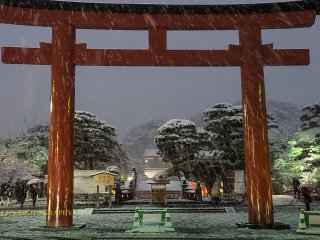It's not often that it snows in Kamakura. In fact it is only the third time that this has happened in the past six years. So when snowflakes begin to fall, it’s time to grab a camera and head out to capture the beauty that we know will only last a few hours. Sure enough, by the following morning the snow was gone and all we were left with were icy roads and wet pavements.
This is what often happens in Japan. Witness the two weeks when the cherry blossoms burst into bloom in late March and early April for a fleeting 10 days, or when the irises and hydrangeas poke out noddingly through the mists and rains of June, or when the pampas grass stalks flower under the harvest moon. On special occasions such as a snowy day in Kamakura, one has to seize the moment and savor it while it lasts!
The first snow
The first snowfall I witnessed in Kamakura was six years ago. What was so unusual was that it happened in November, as it almost never snows here in the first shogun's capital outside of January, February, and March. On that day I chanced across an elderly man in the precincts of Hasedera temple who told me that the experience was such a precious moment - white snow on red and yellow autumn leaves - a sight he had never seen before in his 80-plus years, and one that, he remarked most profoundly, he would probably never see again!
Today's snow
This time I headed up the raised pedestrian walkway, the Dankazura, built right in the middle of Wakamiya Oji, the central boulevard constructed in 1182 by the first shogun, Minamoto no Yoritomo, to pray for the safe delivery of his son, Yoriie. I passed under the giant red torii signifying I was entering sacred ground. Ahead of me was the Taiko-bashii, the drum bridge over which only the shogun was allowed to pass, and beyond that, the Honden and the Maiden, the upper and lower prayer halls that serve as the centerpiece of the shrine complex. The red timber and gold ornamentation gleamed and glistened under the white snow cover.
Usually busy
It was amazing to think that less than a week earlier, the shrine grounds had been awash with visitors coming to offer their prayers and welcome in the New Year. Up to two million people visit the shrine during the first three days of the year, and this year was no exception. In fact, there are so many visitors every year that the authorities have to cordon them off and allow access to only carefully controlled batches.
A chance to be alone
And yet, here I was on a snowy evening almost alone, just seven days after the ancient bell had tolled 108 times to usher in the year 2022. There were some school kids around throwing snowballs and the occasional couple holding hands, but otherwise all was quiet, no voices, no sounds, save the crunch of the snow underfoot. I imagined what it must have been like long ago, at the beginning of the Kamakura Period around the end of the twelfth century. I could almost hear the sound of the drums as Lady Shizuka danced her way into history on the stage before me.
Lady Shizuka
The beautiful Lady Shizuka was a dancer at the imperial court in Kyoto, the lover of Yoshitsune, the half-brother and archrival of the shogun, Yoritomo. Captured by the shogun's forces, she was made to dance at the Maiden and commanded to denounce her lover. Instead, she sang his praises, further angering the shogun. Her story has been immortalized in art and literature, as well as in kabuki and Noh drama, and even in today’s anime.
End of a line
With a further stretch of the imagination, I looked at where the 1,000-year-old gingko tree had stood before it was blown down by a typhoon in 2010. It was behind this tree at the foot of the grand staircase where Kugyo, the shrine’s head priest and son of the second shogun, Yoriie, had hidden himself, disguised as a woman, one snowy night like this in 1202. As his uncle, Sanetomo, the third shogun, was coming down the steps, Kugyo leapt out from behind the tree and beheaded him. Thus ended the Minamoto line, but the Kamakura shogunate continued for another 130 years under the regency of the Hojo family, the first shogun's in-laws.
I wondered what the millions of visitors who had streamed up those stairs in the past few days had prayed and wished for. It didn't take too much imagination to think that it would most likely have been for health and happiness and the well-being of their loved ones, particularly in these troubled times of the Covid pandemic.
I pondered the passage of history as I retraced my way back towards the Dankazura. The snow was falling heavily. I hastened my steps: It was time to head home for some hot sake and oden, just the thing to have on such a cold wintry night!













































